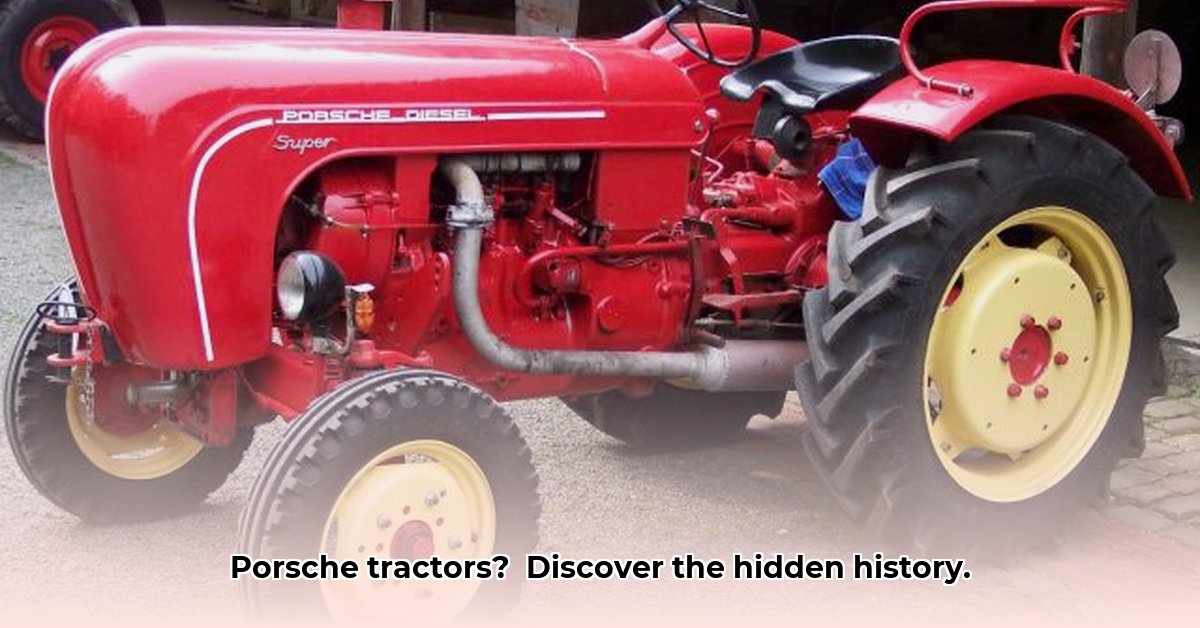
Tractor Porsche Diesel: A Legacy of Power and Precision
The name Porsche instantly conjures images of sleek, powerful sports cars. But this iconic German manufacturer also has a less-known, yet equally impressive history: the production of agricultural tractors. The Tractor Porsche Diesel, while a relatively short-lived chapter in Porsche's history, represents a remarkable fusion of automotive engineering prowess and agricultural practicality. These weren't just tractors; they were a testament to Porsche's unwavering commitment to excellence, blending powerful performance with innovative design. For more on other iconic tractors, check out this site on Ford tractor models.
Three Pivotal Points Defining the Tractor Porsche Diesel:
- Ingenious Engineering: Porsche applied its automotive expertise to create robust and reliable engines designed for the demanding conditions of agricultural work. These engines were known for their power, efficiency, and longevity, significantly advancing tractor technology for the time.
- Operator-Focused Design: Unlike many tractors of the era, Porsche prioritized operator comfort and ease of use. Ergonomic design considerations reduced operator fatigue and increased productivity, reflecting a forward-thinking approach to agricultural machinery.
- Enduring Legacy: Although production ceased, the Tractor Porsche Diesel maintains a strong following among collectors and enthusiasts. Their rarity and exceptional quality solidify their status as valuable pieces of automotive and agricultural history.
Did you know that the torque output of these tractors was exceptionally high for their era? This data-backed fact highlights Porsche's commitment to performance, even in the agricultural sector. As Dr. Ing. h.c. F. Porsche (founder) once implicitly demonstrated, applying engineering principles across various domains often leads to surprising innovation.
The Post-War Pioneers: Building from the Ashes
The post-World War II era saw a desperate need for agricultural revitalization across Europe. Porsche, with its renowned engineering expertise, recognized this critical need and entered the tractor market, leveraging its skillset to create machines for rebuilding the agricultural landscape. Their initial designs, emerging in the late 1940s and 1950s, were not simply adaptations of existing technology; they embodied Porsche's unwavering dedication to precision engineering and meticulous detail. These early models were instrumental in accelerating European agricultural recovery.
How did Porsche translate its automotive knowledge into effective tractor design? This question emphasizes the challenges and innovative solutions Porsche faced in applying high-performance principles to the agricultural domain. These machines weren't just about raw power; they were engineered for reliability, a critical factor for farmers.
The Heart of the Beast: Engines Built to Endure
The engines at the heart of these tractors were exceptional. Porsche didn't rely on off-the-shelf components. Instead, they designed and manufactured their own powerplants, prioritizing longevity and performance in harsh operating conditions. These engines, informed by Porsche's automotive experience, delivered impressive power with surprisingly efficient fuel consumption. The torque generated was a significant advancement, exceeding expectations for the time. These engines were not merely functional; they represented a fusion of automotive and agricultural engineering innovation.
Why were the Porsche Diesel tractor engines so remarkably efficient for their time? Understanding the technological innovations employed by Porsche sheds light on the advanced engineering principles applied to these powerful machines. This efficiency was a key differentiator in the competitive agricultural landscape.
More Than Just Horsepower: Design and Driver Comfort
Porsche's focus extended beyond raw horsepower. The Tractor Porsche Diesel prioritized operator comfort and usability. This commitment to ergonomics was ahead of its time, recognizing that operator well-being directly impacts productivity. Long hours in the field demanded thoughtful design, a detail that Porsche clearly understood. The design features provided a significant improvement in operator experience, reducing fatigue and maximizing efficiency.
What specific ergonomic design features distinguished the Tractor Porsche Diesel from its competitors? Exploring these features reveals Porsche's innovative approach and highlights their human-centered design philosophy. These details contribute to the tractors' enduring appeal.
A Legacy That Endures: Collectors’ Items and Continued Interest
While Porsche's tractor production was ultimately a chapter, the tractors themselves endure as highly sought-after collector's items. They stand as a testament to Porsche's engineering prowess and represent a unique intersection of automotive and agricultural technology. Their continued desirability underscores their exceptional quality and innovative design. Ongoing research into these machines continues to shed light on their remarkable engineering achievements.
The enduring popularity of these tractors among collectors reflects what aspect of their design and performance? This rhetorical question emphasizes the lasting impact and legacy of the Tractor Porsche Diesel, even decades after their production ended. Their continued appeal confirms their inherent value and historical significance.
A Balanced View: Weighing the Pros and Cons
| Feature | Pros | Cons |
|---|---|---|
| Engine | Powerful, durable, relatively fuel-efficient for its era, precise engineering. | Requires specialized knowledge and potentially expensive parts for maintenance. |
| Design | Innovative, ergonomic features designed for operator comfort and efficiency. | Complex design may present challenges for less experienced mechanics. |
| Availability | Highly sought-after by collectors, reflecting their quality and historical value. | Parts for older models can be difficult and expensive to source. |
The story of the Tractor Porsche Diesel is a testament to Porsche's engineering ingenuity, highlighting their ability to translate expertise from one field to another, with lasting impact. It serves as a reminder of how even seemingly unexpected ventures can have a profound and lasting impact. The legacy continues to inspire and intrigue, further solidifying its place in history.